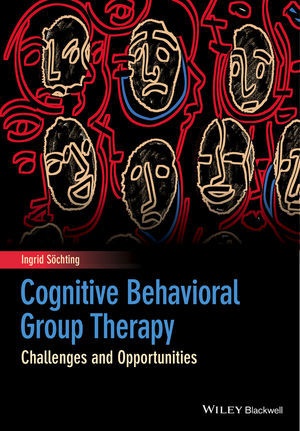Read more
With coverage of the latest theory and research, this is a complete guide to implementing cognitive behavioral group therapy for practitioners and trainees in a range of mental health disciplines.
* Presents evidence-based protocols for depression, panic, social anxiety, generalized anxiety, posttraumatic stress, OCD, compulsive hoarding, psychosis, and addiction
* Provides innovative solutions for achieving efficient, effective therapy as mandated by emerging health care priorities, as well as trouble-shoots for common problems such as dropouts
* Details unique strategies for working with ethnic minorities and clients across the age spectrum, along with material on mindfulness augmentation and transdiagnostic approaches
* Includes clear, accessible instructions, complete with references to DSM-5 diagnostic changes, real-life clinical examples, and group session transcripts
List of contents
About the Author xv
Acknowledgments xvi
Introduction: The Depth and Breadth of Cognitive Behavior Group Therapy 1
Part 1 The Basics of Cognitive Behavioral Group Therapy 5
1 Extending CBT to Groups 7
Why CBT Is Increasingly Used for Common Mental Health Problems 7
Principles of CBT 9
Cost-Effectiveness of CBT 11
Transporting Individual CBT to a Group Setting 12
Adapting CBT to CBGT: panic disorder illustration 13
Managing the group process across CBGT 15
Unique Benefits of the Group Format 17
How to Start a CBT Group 19
Setting up the group room 20
The first session 20
Absences and being late 22
Confidentiality and socializing outside the group 22
Member introductions 23
Expectations for CBGT commitment 24
Note-taking by CBGT therapists 24
Subsequent sessions 25
Summary 25
Notes 26
Recommended Readings for Clinicians 26
References 26
2 Working with Process and Content 29
Process and Content in Group Therapy 30
Group Process in Theory 31
Group Process in Practice: Obsessive-Compulsive Disorder Illustration 32
Instillation of hope 32
Universality 34
Imitative behavior and peer modeling 34
Imparting of information 35
Altruism 35
Group cohesiveness 36
Existential factors 37
Catharsis 37
Interpersonal learning and new ways of socializing 38
Experiencing the group as similar to one's family of origin 39
Group process research and CBGT application 40
Scott's General Group Therapeutic Skills Rating Scale 41
Summary 42
Note 42
Recommended Readings for Clinicians 42
References 42
3 Effectiveness of CBGT Compared to Individual CBT: Research Review 44
Depression 46
Social Anxiety Disorder (SAD) 47
Obsessive-Compulsive Disorder (OCD) 49
Generalized Anxiety Disorder (GAD) 50
Panic Disorder 50
Posttraumatic Stress Disorder (PTSD) 51
Addictions 52
Psychosis 52
Hoarding 52
Language and Culture 53
What to Take Away from the Research Findings 53
Summary 54
References 54
4 CBGT for Depression: Psychoeducation and Behavioral Interventions 59
The Diagnoses of Depression 60
Treatment Protocols Informed by Beck's Cognitive Model of Depression 61
An Example of a CBGT Depression Protocol 63
Psychoeducation 63
Behavioral Interventions 66
Focus on Emotions in Preparation for the Thought Records 70
Capitalizing on the Group in CBGT for Depression 71
Summary 72
Notes 72
Recommended Readings for Clinicians 72
References 72
5 CBGT for Depression: Cognitive Interventions and Relapse Prevention 74
The Thought Record in a Group 76
Other Cognitive Interventions 81
Testing assumptions 82
Testing core beliefs 83
Behavioral experiments 84
CBGT Psychodrama 85
Relapse Prevention 86
Mindfulness-Based Cognitive Therapy (MBCT) 87
Summary 90
Note 90
Recommended Readings for Clinicians 90
References 91
Part 2 Challenges of Cognitive Behavioral Group Therapy 93
6 How to "Sell" CBGT, Prevent Dropouts, and Evaluate Outcomes 95
Drawing People into CBGT 95
Preparing C
About the author
Ingrid Söchting is Chief Psychologist in an outpatient mental health program and Clinical Assistant Professor in the Department of Psychiatry at the University of British Columbia. She has been instrumental in developing CBT group therapy programs for depression, OCD, panic disorder, social anxiety, and PTSD, as well as interpersonal therapy (IPT) groups for later life depression. She supervises and teaches CBT and IPT to psychology and psychiatry residents, and is co-director of the Richmond Psychotherapy Training Program. She has also published over 25 peer-reviewed journal articles and book chapters in the field; and is a Canadian certified CBT therapist and a Certified Group Therapist of the American Group Psychotherapy Association.
Summary
This is a complete guide to implementing cognitive behavioral group therapy across a range of mental health contexts. It presents evidence-based protocols for key psychological disorders and innovative solutions for common problems related to group therapy.
Report
"Even the most experienced clinician will be able to find some practical help, useful tips and research references." ( British Psychological Society , 1 January 2015)

